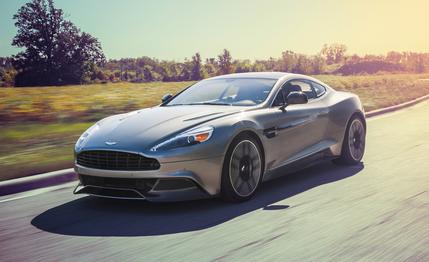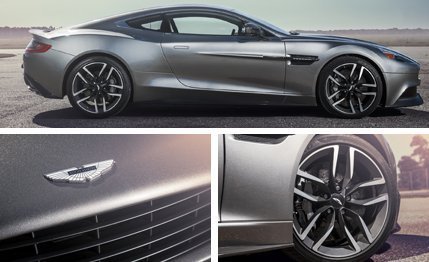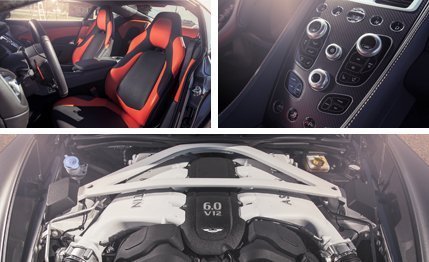 Instrumented Test
Instrumented Test
What is there to say about the 2015 Aston Martin Vanquish that hasn’t already been said? This mildly tweaked version has gained a couple of transmission ratios and some revised damper settings, and there are some natty new color options to pick from, too. But otherwise it remains as before, the ultimate expression of what we’ll call Aston’s “Dr. Bez Era.” And while the most expensive Aston coupe has many admirable qualities, newness is not among them. It sits on the same venerable VH architecture that has underpinned the company’s products since 2004, and it is powered by a development of the same 5.9-liter V-12 that can trace its ancestry back even further. (Thankfully, a new platform is on the way, as are AMG-sourced V-8 engines.)
Ah, but to turn the question around, what really needs to change? The Vanquish sits in a segment where its rivals are newer and faster. But its flaws tend to be the character-enhancing sort that happen when you hand-build a car in tiny volumes. And the Vanquish, as before, does an almost perfect job of being an Aston Martin—big, impeccably styled, slightly old-fashioned. The sort of car you could imagine a dissolute European playboy driving away from a casino as the sun comes up. It delivers to its owners the sort of exclusivity that—by its very definition—you can’t buy. This is a car that makes a Lamborghini Aventador look commonplace, a Ferrari F12berlinetta a default choice.
Let’s start with what’s different. That’s pretty much one thing: the new eight-speed automatic transmission. Okay, so this is actually the same ZF gearbox that’s been used in many other sports cars, but to make it fit, Aston has gone to the considerable trouble and expense of reengineering it for the Vanquish’s transaxle layout. And although in the everyday part of the auto industry the arrival of more ratios inevitably signifies an economy boost, here it’s been done to increase performance. The old Vanquish was limited by gearing to a mere 183 mph, but now—with no other mechanical change—it can hit a claimed 201 mph. Yes, in this part of the market, these things matter. (Owners are much less likely to boast about the 2015 Vanquish’s 2-mpg improvement on the EPA highway cycle.)

We didn’t confirm that 201-mph figure, you’ll be unsurprised to hear. On the test track, however, the Vanquish proved that, while it’s among the slower cars in its rarefied segment, it’s definitely no slouch, recording a 3.6-second zero-to-60-mph time and an 8.3-second sprint to 100 mph. On the road, the new transmission feels no different from the last, shifting sensibly when treated like an automatic and doing a good job of hiding the engine’s relative lack of low-end torque. Take control of gear selection via the two metal paddles behind the steering wheel and there’s enough hesitation to confirm you’re still dealing with a torque converter and planetary gearsets rather than dual clutches that engage instantly. But you get used to it quickly.
The 5.9-liter V-12 engine is unchanged from before. So there’s no need to say anything about it.
We’re kidding. It would have been easy to turn this entire story into an overwrought teenage love poem dedicated to the engine’s sonorous charms. Because while the V-12 might not be able to match more-modern rivals on raw power, you will search the world in vain for a more charismatic powerplant. At low revs it burbles like a V-12 should, with a lazy, creamy wuffling that sounds like money. But as soon as you add revs, the noise hardens. Beyond 5000 rpm it’s delivering the sort of resonant wail that might well—if you drove past a cemetery on a Friday the 13th and under a full moon—reanimate several corpses.
But it’s not just the yowling, howling soundtrack that makes the engine special. It’s also the way it responds. The long-travel accelerator delivers without digital delay—there’s no feeling of instructions being processed or turbines gathering momentum. It’s as if there’s an actual cable twisting some actual throttle butterflies. And with no turbos to get in the way, it’s almost perfectly proportional and linear, giving the sense that you can call on the horsepower pretty much one-by-one, and offers responses quick enough to get you looking up metaphors for sharpness. We think that “as truth” is probably the best, so it’s the one that gets used here.

The suspension has been firmed up very slightly compared with the 2014 car. There are slightly stiffer dampers and a fatter rear anti-roll bar. These changes aren’t terribly noticeable; the Vanquish still feels big and heavy when asked to press on and impressively wafty when asked to waft. But it’s an enormously rewarding car to drive as well, and its hydraulic power steering system is an object lesson in what gets lost when you switch to fully electric systems. The fat-rimmed leather steering wheel is direct and responsive, although low geared when compared with the frenetic helm of the Ferrari F12, and it also offers feedback beyond just digitally generated weighting, vibrating over rough surfaces and kicking back over bumps. It’s the sort of stuff that newer systems often filter out as unwanted noise but which help you to feel like you’re part of the feedback loop rather than a distant node.
As always, the Vanquish is happiest when asked to digest a serious journey at a high average speed. The cabin lacks the toys and gadgetry of the competition. There’s no touch-sensitive screen, and navigational duties are still handled by a garish display that climbs from the top of the dashboard seemingly straight from 2005. But—once you have it connected to your music device—the audio system sounds great and the seats stay comfortable for long enough that cruising stints are likely to be limited either by your bladder or by the relative smallness of the Vanquish’s 20.6-gallon fuel tank against its thirst for gas. The car’s natural cruising speed is probably about 120 mph, at which point the cabin is still quiet enough for conversation in normal tones.
The Vanquish remains a glorious thing, even if it feels as if it has been out-evolved by the rest of the pack. And yet it has as much character as any of its more-modern competitors—and more than most of them. As much as we’re looking forward to Aston’s brave new era, the company should never lose sight of how to make cars like this.